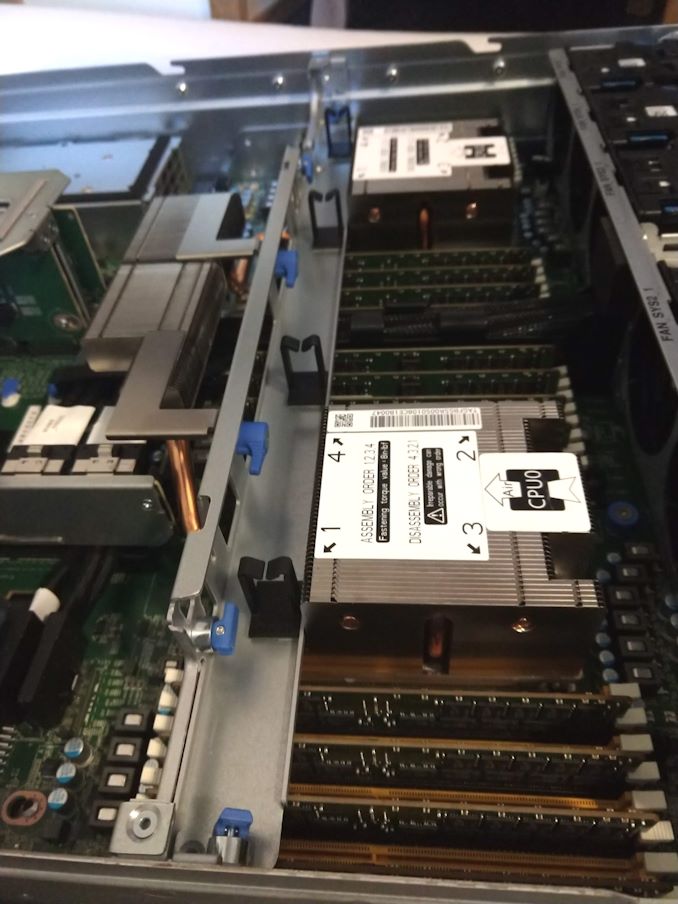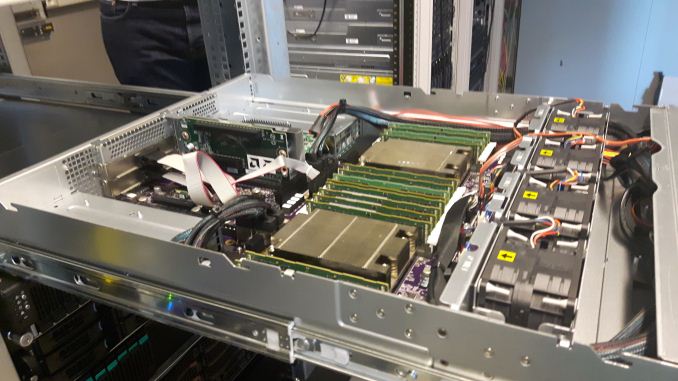AMD Rome Second Generation EPYC Review: 2x 64-core Benchmarked
by Johan De Gelas on August 7, 2019 7:00 PM ESTMurphy's Law
Anything That Can Go Wrong, Will Go Wrong
For those of you that may not know, I am an Academic Director of MCT at Howest University here in Belgium. I perform research in our labs here on big data analytics, virtualization, cloud computing, and server technology in general. We do all the testing here in the lab, and I also do launch article testing for AnandTech.
Undoubtedly, like most academic institutions, we have a summer vacation, where our labs are locked and we are told to get some sunlight. AMD's Rome launch has happened just as our lab closing started, and so I had the Rome server delivered to my home lab instead. The only issue was that our corresponding Intel server was still in the academic lab. Normally this isn't really a problem - even when the lab is open, I issue testing through remote access and process the data that way, in order to reboot the system and run tests and so forth. If a hardware change is needed, I need to be physically there, but usually this isn't a problem.
However, as Murphy's Law would have it, during testing for this review, our Domain Controller also crashed while our labs were closed. We could not reach our older servers any more. This has limited us somewhat in our testing - while I can test this Rome system during normal hours at the home lab (can't really run it overnight, it is a server and therefore loud), I couldn't issue any benchmarks to our Naples / Cascade Lake systems in the lab.
As a result, our only option was to limit ourselves to the benchmarks already done on the EPYC 7601, Skylake, and Cascade Lake machines. Rest assured that we will be back with our usual Big Data/AI and other real world tests once we can get our complete testing infrastructure up and running.
Benchmark Configuration and Methodology
All of our testing was conducted on Ubuntu Server 18.04 LTS, except for the EPYC 7742 server, which was running Ubuntu 19.04. The reason was simple: we were told that 19.04 had validated support for Rome, and with two weeks of testing time, we wanted to complete what was possible. Support (including X2APIC/IOMMU patches to utilize 256 threads) for Rome is available with Linux Kernel 4.19 and later.
You will notice that the DRAM capacity varies among our server configurations. This is of course a result of the fact that Xeons have access to six memory channels while EPYC CPUs have eight channels. As far as we know, all of our tests fit in 128 GB, so DRAM capacity should not have much influence on performance.
AMD Daytona - Dual EPYC 7742
AMD sent us the "Daytona XT" server, a reference platform build by ODM Quanta (D52BQ-2U).
| CPU | AMD EPYC 7742 (2.25 GHz, 64c, 256 MB L3, 225W) |
| RAM | 512 GB (16x32 GB) Micron DDR4-3200 |
| Internal Disks | SAMSUNG MZ7LM240 (bootdisk) Micron 9300 3.84 TB (data) |
| Motherboard | Daytona reference board: S5BQ |
| PSU | PWS-1200 |
Although the 225W TDP CPUs needs extra heatspipes and heatsinks, there are still running on air cooling...
AMD EPYC 7601 – (2U Chassis)
| CPU | Two EPYC 7601 (2.2 GHz, 32c, 8x8MB L3, 180W) |
| RAM | 512 GB (16x32 GB) Samsung DDR4-2666 @2400 |
| Internal Disks | SAMSUNG MZ7LM240 (bootdisk) Intel SSD3710 800 GB (data) |
| Motherboard | AMD Speedway |
| PSU | 1100W PSU (80+ Platinum) |
Intel's Xeon "Purley" Server – S2P2SY3Q (2U Chassis)
| CPU | Two Intel Xeon Platinum 8280 (2.7 GHz, 28c, 38.5MB L3, 205W) Two Intel Xeon Platinum 8176 (2.1 GHz, 28c, 38.5MB L3, 165W) |
| RAM | 384 GB (12x32 GB) Hynix DDR4-2666 |
| Internal Disks | SAMSUNG MZ7LM240 (bootdisk) Micron 9300 3.84 TB (data) |
| Motherboard | Intel S2600WF (Wolf Pass baseboard) |
| Chipset | Intel Wellsburg B0 |
| PSU | 1100W PSU (80+ Platinum) |
We enabled hyper-threading and Intel virtualization acceleration.












180 Comments
View All Comments
wrkingclass_hero - Sunday, August 11, 2019 - link
What does AMD have to do to get a Gold or Platinum recommendation?oRAirwolf - Thursday, August 15, 2019 - link
This is a good questionimaskar - Sunday, August 11, 2019 - link
Single thread performance is very important for those who lives in cloud. A quick example: suppose I provision 2 core/4gig vm (this is of course hyperthreads). And on AWS I have a choice - m5 and m5a, where AMD is cheaper. What do I sacrifice? Not really throughput, because you don't run your prod workloads at 100% CPU. But there is the latency. If those cores clocked lower, I would get the same amount of responses, but slower. And since in microservice world you have a chain of calls, you get this decrease 10 times. Is it worth it?That was the case for 1st gen EPYC. Would 2nd gen have latency parity?
notashill - Sunday, August 11, 2019 - link
It's hard to say until the cloud instances actually launch.The current m5a instances are using a custom SKU which is clocked at 2.5GHz max boost.
Rome's IPC is ~15% higher and clock speeds are all around higher so single threaded performance should be quite a bit better, but ultimately the exact numbers will depend on which SKUs the cloud vendors decide to use and how high they clock.
duploxxx - Tuesday, August 13, 2019 - link
did you actually ever work with hypervisors?there are other things than raw clock speed.... its all about scheduling and when there are more cores / socket available the scheduling is more relaxed, less ready time..... EPYC generation 1 is already awesome for hypervisor way better choice than most Intel counter parts for sure if you look at socket cost... but than again I am probably talking to a typical retard ****
JoeBraga - Wednesday, August 14, 2019 - link
Can you Explain better? But the license isn't bought by the quantity of coresor Per socket?imaskar - Wednesday, August 14, 2019 - link
He probably talks about VmWare, which is licensed per socket, not per core. So with EPYC gen2 you need twice less licenses for the same cloud capacity (assuming cores are equal).JoeBraga - Wednesday, August 14, 2019 - link
Now I understoodimaskar - Wednesday, August 14, 2019 - link
Rather than calling others retards, you could first dig a little deeper into an issue. No, I don't work with hypervisors directly, I'm from the other side. I write software and I want good latency (not insane one like for HFT, but still a good one). Because for throughput we could just spin one more instance. You can't buy latency horizontally.I'm not taking numbers out of the blue. There is a benchmark for AMD instances vs Intel instances on AWS. I'm not sure if we are allowed to post links to other resources here. Put this string into Google and you will surely find it: "A Look At The AMD EPYC Performance On The Amazon EC2 Cloud". Despite this article being very enthusiastic about those instances, you can really see that per core performance on Intel is better, meaning better latencies for web apps.
I will probably write my own set of benchmarks, because that one seems to completely ignore web servers. I am very enthusiastic about AMD instances, but they are definitely not a no-brainer.
quadibloc - Tuesday, August 13, 2019 - link
The new Ryzen chips compete well with what Intel is currently producing. But while they doubled AVX 2 support, so as to match what Intel has, Ice Lake will double that - as has been known for some time. So if this is what AMD thought would be competitive with Ice Lake, as Forrest Norrod said, AMD was not trying hard enough - and they're just lucky Ice Lake was late. AMD's position relative to Intel with its previous generations of Ryzens seems to be the limit of their ambitions. Combine that with Intel reacting to its current issues, and it looks to me that AMD will have to rethink some aspects of its strategy to avoid Intel being ahead when it comes time for next year's chips from both companies.